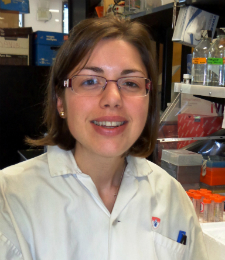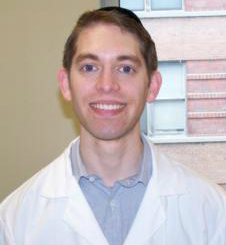Meet our research trainees
In every field of child health and development, our graduate students and postdoctoral fellows share the hope of finding better treatments and future cures for today’s diseases. In profile, here are some of tomorrow’s researchers training at the Montreal Children’s Hospital (MCH) today.
---------------------------------------------------------------------------------------------------------------------------------------------------------------
“The best part is when you get things to work!”
 Esterina D'Asti, doctoral student
Esterina D'Asti, doctoral student
Department of Pediatrics, McGill University
- Supervisor: Dr. Janusz Rak
- Lab/Research program: Cancer and Angiogenesis Research
- Project: Regulation of cancer coagulome by micro-ribonucleic acid (miRNA)
- External bursary: Fonds de recherche du Québec–Santé
Q & A
Q: What is your research about?
Esterina: I’m studying brain tumours in children, and how clotting affects the growth or development of those tumours.
Q: When did you start thinking about science as a career path?
Esterina: I was in Grade 4. My Dad had cancer that year, and I was trying to “diagnose” him. I started reading a lot of scientific stuff, trying to learn what cancer was. At the time, I was inspired to go into medicine because of the amazing team of doctors who were taking care of my Dad.
Q: Did your goals change as you grew older?
Esterina: In my last year of high school I thought of becoming a baker, or something completely different! But that wasn’t very serious…. I never really doubted going into science. In college I considered engineering because I loved math and physics, and I had a lot of admiration for a math teacher who was an engineer. I admired my father, too. He’s an electrician, and very knowledgeable in those subjects. But I decided to continue in biology.
Q: So you knew all along what you wanted?
Esterina: In elementary school I knew I wanted to go into the sciences, but it was in university that I decided to specialize in cancer research. I had my first opportunity when I was accepted to work on a project with Dr. Nada Jabado at the MCH, just before starting my Master’s degree.
Q: As a doctoral student, what’s the biggest challenge in lab work?
Esterina: It’s when you’re learning techniques and establishing yourself in the lab. With my project, no one [in our lab] had done many of these experiments before, and so it was a major challenge for me.
Q: What’s the best part?
Esterina: The best part is when you get things to work – when you solve the problems, know why your technique or experiment isn’t working.
Q: How do you feel then?
Esterina: I feel an overwhelming sense of joy! When I get my experiments to work, then everything else doesn’t matter. Not even when machines break down, or the chaos when there’s a shortage of tissue culture hoods…. Everything’s OK!
Q: Are the dynamics of working in a lab team what you expected?
Esterina: That can vary. Where I did my Master’s degree, we had technicians that helped us with established protocols in the lab and they walked you through it. Here we’re more independent. We make our own mistakes and learn from them. The dynamics are different, and you adapt.
Q: So being adaptable is one good quality in a researcher. What else?
Esterina: It takes a lot of patience, too, including the patience to communicate effectively with other personalities.
Q: What would you tell a younger student wanting to go into cancer research?
Esterina: You have to be dedicated, not give up when things look bad. Try your best and things will eventually fall into place!
-------------------------------------------------------------------------------------------------------------------------------------------------------------
"Creativity is really the ultimate driver of scientific investigation.”

Gabriel Kaufman, doctoral student
Experimental Medicine, McGill University
Supervisor: Dr. Bruce Mazer
Lab/Research program: Pediatric Allergy and Immunology
Project: Cellular and molecular mechanisms of intravenous immunoglobulin (IVIG) in allergic asthma
External bursary: Canadian Institutes of Health Research
Q & A
Q: What’s the work in your lab all about?
Gabriel: We’re trying to understand how allergic asthma happens, to try to treat or prevent it. We’ve identified some of the cells that make asthma the disease it is and think we have some ways to target those cells.
Q: When did you start thinking about becoming a scientist?
Gabriel: In high school. I had a wonderful science teacher, and she really opened our eyes. She showed us—in addition to the nitty-gritty information—what a hypothesis means, how an experiment’s planned, how to think about proving something or suggesting something in science.
Q: What keeps you on that career path now?
Gabriel: I enjoy what goes into doing the science: the thought process, the experimental precision, the hope that your work will help people. And in asthma, the current treatment options are not so great. Most of them have side effects, or they don't specifically fix what causes the disease. As I work for a clinician, we’re very cognizant of these limitations. We want to figure out better ways to treat the disease. If we could get a kid to breathe happily, without the effects of the steroids we use—especially those kids who don’t respond to steroids—for me, it’s about taking knowledge that we have, and trying to improve it. And making that kid better, happier, healthier. This is what motivates me.
Q: What qualities does a scientist need to have?
Gabriel: You have to think critically, be analytic, and be very focused. Especially when the research doesn’t go well the first time, the second time, or even the third time that you try it, you have to be persistent. And also, creative!
Q: In what way does a scientist need to be creative?
Gabriel: Creativity is really the ultimate driver of scientific investigation. Because if you think about it, for anything we want to know … the first thing to do is to step back and analyse the question, then how we’re going to try and figure it out, how to prove or improve something. And to do that, you have all these tools at your disposal and you have to deploy them in the most effective manner. There’s a lot of art in that. Definitely a creative mindset. In addition to the precision and the detail-orientation, scientists are free-thinkers.
Q: What’s down the road in asthma and allergy research?
Gabriel: In the long term for asthma we’ll have to move away from the current mainstays of treatment, the steroid puffers like Ventolin, and come up with some therapeutic strategies that target causes behind the disease. Instead of treating the symptoms, treat the root causes. That’s what our work is focusing on.
